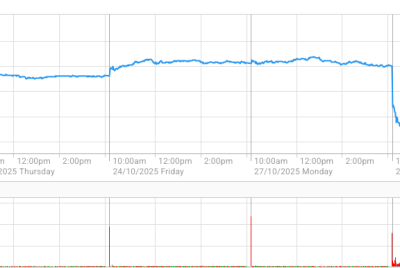ASX 200 Ends Wild October with Tiny Loss — But the Month Was Anything But Calm

WHAT HAPPENED:
Friday's Close: The ASX 200 slipped 3.60 points or 0.04% to close at 8,881.90 on Friday, October 31, ending a tumultuous month on a relatively quiet note.
October's Chaos: The index erased all gains from the past 60 days, falling from near-record highs after hot inflation data killed hopes of another RBA rate cut. October historically averages the most volatile monthly range at 7.2%, and this year lived up to that reputation.
The Big Movers: Domino's Pizza was October's star performer, surging 35.9% on takeover speculation. Pilbara Minerals jumped 31% and Liontown Resources gained 19.2%. On the flip side, CSL crashed 15% in a single day after a revenue downgrade, while Wesfarmers plunged 7%.
What's Next: Markets are watching for next week's U.S. election results and the RBA's November meeting, with rate cut expectations now pushed to 2026.
A Month of Two Halves
October started with optimism. The ASX 200 surged to a fresh record high of 9,109.7 after soft September employment data reignited expectations of an RBA rate cut.
Then reality hit hard.
Hot CPI data on Wednesday, October 29 triggered the index's sharpest fall in eight weeks, killing any hope of another RBA rate cut this year. The benchmark index broke lower from a pattern near record highs in what traders call a "bearish range expansion day."
By Friday's close, the ASX 200 sat well below where it started the month, with the index up just 0.28% for October after giving back earlier gains.
"The monthly candle is on track to form a shooting star, warning that a larger bearish reversal could be developing," according to market analysts watching chart patterns.
The Inflation Shock That Changed Everything
The week's pivotal moment came Wednesday when Australia's quarterly inflation data came in hotter than expected. The Consumer Price Index showed inflation remains stubbornly elevated, forcing traders to abandon hopes for RBA rate cuts in 2025.
The ASX 200 suffered its worst day in eight weeks following the hot CPI report, with volatility spiking to a two-week high.
Banks bore the brunt of the selloff. Westpac fell 3% in its worst session in seven weeks, becoming the weakest performer of the big four banks. National Australia Bank dropped 2.6%. Traders bet that the end of the RBA's cutting cycle could eat into banking profits.
Real estate stocks also tumbled, falling 2.3% as sentiment was weighed by the RBA's high-for-longer policy stance.
Sector Carnage: Consumer Discretionary Gets Hammered
The inflation news hit consumer-facing companies particularly hard.
Consumer Discretionary led seven sectors lower, sliding 4.2% — its worst daily performance in six months. Wesfarmers, owner of Bunnings and Kmart, plunged 7% to a 12-week low, marking its worst day in two and a half years.
The sector's collapse reflects a harsh reality: with interest rates staying higher for longer, Australian consumers are pulling back on discretionary spending. Companies like Wesfarmers that rely on consumer confidence are feeling the pain.
Information Technology also struggled, dropping 1.5%, underscoring the broad risk-off tone that gripped markets in October's final days.
October's Biggest Winners: Pizza, Lithium, and Gold
Despite the overall market turbulence, some stocks had spectacular months.
Domino's Pizza: The pizza chain operator was October's best performer with a 35.9% gain. The catalyst? Speculation that it's a takeover target of a large private equity firm.
While Domino's denied receiving any proposal from Bain Capital, investors bet that "there's no smoke without fire." The stock rocketed higher on dreams of a buyout premium.
Pilbara Minerals: The lithium miner surged 31% after delivering a stronger-than-expected first quarter update, with production up 2% and average realized prices jumping 20%.
The lithium sector got a boost from improving sentiment and hopes that oversupply concerns may be easing.
Liontown Resources: Another lithium play, Liontown gained 19.2% on improving industry sentiment and a solid quarterly update. Broker Bell Potter retained its buy rating with an improved price target of $1.30.
Gold miners: Evolution Mining and Northern Star Resources benefited from gold rising to US$4,037.20 an ounce, with the precious metal hitting new highs on rate cut expectations.
The CSL Disaster
The month's biggest single-day disaster belonged to healthcare giant CSL.
CSL fell 15% on Tuesday, October 28, suffering its worst day since August following a revenue guidance downgrade. The biotech firm cited an unprecedented decline in US immunization rates.
As the fourth-largest company on the ASX 200 by market cap, CSL's collapse dragged the entire index lower. The healthcare sector, which had been one of the stronger performers earlier in the year, suddenly looked vulnerable.
What the Charts Are Saying
Technical analysts are seeing warning signs beneath the surface.
The Consumer Discretionary to Consumer Staples ratio is flashing red. Consumer Discretionary has fallen sharply with the ASX 200, while Consumer Staples has been trending higher. This divergence suggests investors are fleeing to defensive stocks — never a good sign for market bulls.
Another concerning ratio: Materials versus Technology. The Materials sector remains in a solid uptrend aligned with commodity strength, while Technology has been topping out since July.
This kind of sector rotation — away from growth and toward commodities — typically signals that investors are bracing for tougher economic times ahead.
Friday's Setup Looked Promising — Then Failed
The Australian share market was expected to rise on Friday, with SPI futures pointing to a 17-point or 0.2% gain.
Instead, the index barely budged, closing fractionally lower. It was a fitting end to a month that repeatedly defied expectations.
Several factors weighed on sentiment:
- Wall Street closed lower Thursday night, with the Dow down 0.2%, the S&P 500 down 0.9%, and the Nasdaq sinking 1.45%
- Oil prices eased overnight, with WTI crude down 0.1% to US$60.41 a barrel, pressuring energy stocks
The one bright spot: Gold futures rose 0.9% to US$4,037.20 an ounce after a U.S. interest rate cut, providing support for gold miners.
Looking Ahead: November Challenges
As October closes, investors face an uncertain November with several major events looming:
U.S. Election: Results expected early next week could trigger volatility across global markets
RBA Meeting: The Reserve Bank meets in early November, but rate cut expectations have evaporated after the hot inflation data
Earnings Season Continues: Companies like ResMed released first-quarter updates, with Morgan Stanley expecting a 7% revenue decline compared to Q4 but a 5% increase year-over-year
Market analysts warn that "with inflation pressures lingering and bond yields rising, cyclical sectors continue to underperform defensives, suggesting rallies may remain capped in the near term".
The Correlation Breakdown
One of October's most unusual developments was the breakdown in typical market correlations.
The ASX 200's relationship with Wall Street indices has effectively broken down over the past 10 days, with the Nasdaq 100 and S&P 500 pushing to record highs while ASX momentum turns lower.
Even correlations between the ASX 200 and its two largest sectors — Financials and Materials — are weakening, suggesting smaller-cap stocks are driving short-term moves.
This kind of correlation breakdown often precedes larger market moves, though whether that means a bounce or further decline remains unclear.
What Investors Should Watch
As we head into November, several factors will determine whether October's losses continue or reverse:
Inflation Data: Another hot CPI print would cement expectations for higher-for-longer rates, pressuring stocks further
Consumer Spending: With discretionary stocks getting hammered, retail sales data will show if consumers are truly pulling back
China: As Australia's largest trading partner, any weakness in Chinese economic data could pressure materials and energy stocks
Commodity Prices: Iron ore, lithium, and gold movements will continue driving significant portions of the index
The Bottom Line
October 2025 reminded investors that markets don't go up in straight lines. The ASX 200 closed at 8,881.90, barely changed for the month at +0.28%, but that figure masks extraordinary volatility beneath the surface.
Record highs early in the month gave way to sharp declines after inflation data dashed rate cut hopes. Individual stocks swung wildly — Domino's Pizza up 36%, CSL down 15% in a single day, banks sliding on rate fears.
The shift from growth to defensive stocks, the breakdown in market correlations, and technical warning signs suggest the easy gains of 2024 may be over. Investors might be in for a rougher ride as we close out 2025.
For traders who lived through October's chaos, Friday's near-flat close probably felt like relief. But the question everyone's asking is: was this month's volatility just a blip, or a preview of what's coming?
Based on the technical signals and sector rotation patterns, smart money is preparing for more turbulence ahead.
© Copyright 2025 IBTimes AU. All rights reserved.





















